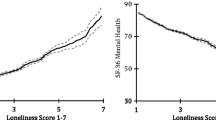Abstract
Integrating individual inequity aversion (Fehr and Schmidt in Q J Econ 114:817–868, 1999) into a utilitarian social welfare function, we derive a simple welfare measure which comprises both GDP and income inequality as measured by the Gini-index.
Similar content being viewed by others
Notes
text
The measurement of economic welfare has also received substantial attention in the current political debate. An example is the “beyond GDP initiative” of the European Commission, the European Parliament, the Club of Rome, OECD and WWF which has promoted the development of welfare indicators which are as clear and appealing as the traditionally used GDP, but more inclusive of environmental and social aspects of progress (see https://ec.europa.eu/jrc/en/event/beyond-gdp-measuring-progress-true-wealth-and-well-being-nations-7763).
See Rohde (2010) for an axiomatic foundation of the Fehr and Schmidt model.
For example, the lowest income is weighted by \(\frac{1}{n}+\frac{\alpha +\beta }{n}>\frac{1}{n}\), the highest income by \(\frac{1}{n}-\frac{\alpha +\beta }{n}<\frac{1}{n}\) whereas the median income receives precisely the weight 1 / n.
For this specific example, the trade-off between average income and equality is determined by the sum of \(\alpha \) and \(\beta \), i.e. the sum of parameters of aversion to disadvantageous and advantageous inequity. This is arguably an artefact of the simplifications made in the choice of individual utility functions (for \(\alpha + \beta =1\), we obtain the special case of \(W=\mu (1-G)\); cf. Sen 1974). In general, we would indeed expect the relative weighing to be more complex. The purpose of this paper, however, was not to determine the best possible social welfare function but only to demonstrate that once we acknowledge monetary and distributional preferences on an individual level this translates rather simply—by aggregation—into a combination of well known social measures of aggregate wealth and distributional aspects.
Ben Porath and Gilboa define various axioms for a social preference relation, including inequity aversion regarding the distribution of income in society. As a result, they obtain a social welfare function, similar to the one derived here, combining aggregate income and the Gini index. Different from the present approach, they do not consider individual preferences, though. By contrast, the present approach shows that if individual preference relations display inequity aversion such that they can be represented by Fehr-Schmidt utility, the Gini coefficient arises naturally as welfare measure.
See Footnote 4.
References
Ben Porath E, Gilboa I (1994) Linear measures, the Gini index, and the income-equality trade-off. J Econ Theory 64:443–467
Daly HE, Cobb JB (1989) For the Common good: redirecting the economy toward community, the environment, and a sustainable future. Beacon Press, Boston
Decerf B, van der Linden M (2016) Fair social orderings with other-regarding preferences. Soc Choice Welf 46:655–694
Fehr E, Schmidt K (1999) A theory of fairness, competition, and cooperation. Q J Econ 114:817–868
Fleurbaey M (2012) The importance of what people care about. Polit Philos Econ 11:415–447
Fleurbaey M, Blanchet D (2013) Beyond GDP: measuring welfare and assessing sustainability. Oxford University Press, Oxford
Gini C (1912) Variabilita e metuabilita. Contributo allo studio delle distribuzioni e delle relazioni statistiche. C. Cuppini, Bologna
Neumayer E (1999) The ISEW—not an index of sustainable economic welfare. Soc Indic Res 48:77–101
Rohde K (2010) A preference foundation for Fehr and Schmidt’s model of inequity aversion. Soc Choice Welf 34:537–547
Sen A (1974) Informational bases of alternative welfare approaches: aggregation and income distribution. J Public Econ 3:387–403
Treibich R (2018) Welfare egalitarianism with other-regarding preferences. Soc Choice Welf. https://doi.org/10.1007/s00355-018-1135-3
https://ec.europa.eu/jrc/en/event/beyond-gdp-measuring-progress-true-wealth-and-well-being-nations-7763. Accessed 10 April 2018
Author information
Authors and Affiliations
Corresponding author
Additional information
We thank Ernst Fehr, Marc Fleurbaey, Itzhak Gilboa, Klaus Schmidt, James Konow, Dirk Engelmann, Dennis Snower, Gianluca Grimalda, Christian Seidl and an anonymous reviewer for helpful comments on earlier drafts of this paper. The usual disclaimer applies.
Rights and permissions
About this article
Cite this article
Schmidt, U., Wichardt, P.C. Inequity aversion, welfare measurement and the Gini index. Soc Choice Welf 52, 585–588 (2019). https://doi.org/10.1007/s00355-018-1149-x
Received:
Accepted:
Published:
Issue Date:
DOI: https://doi.org/10.1007/s00355-018-1149-x




